- JP
- EN
Sustainability Issues (Materiality)
- Our Sustainability Issues (Materiality)
- Identification and Review of Sustainability Issues
- MOL Sustainability Plan
- 'MOL Sustainability Plan' FY2022 Results
Our Sustainability Issues (Materiality)
The MOL Group identifies "Sustainability Issues" (Materiality) as our key issues for sustainable growth with society through realization of the Group Vision.
Based on enhancement of "Governance," which is foundation of MOL Group management, the group addresses issues of "Safety & Value" and "Environment," while "Innovation" and "Human & Community" are closely inter-related. We strive to improve the group's corporate value and contribute to realizing a sustainable society by moving forward with these initiatives.
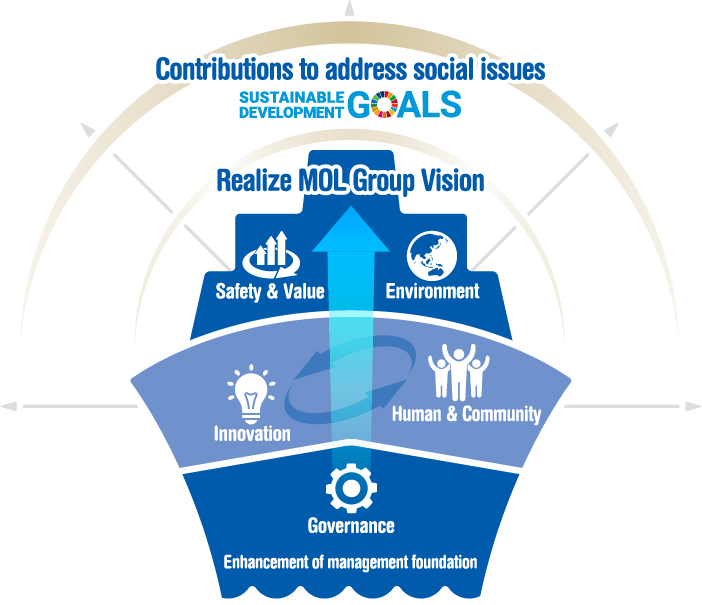
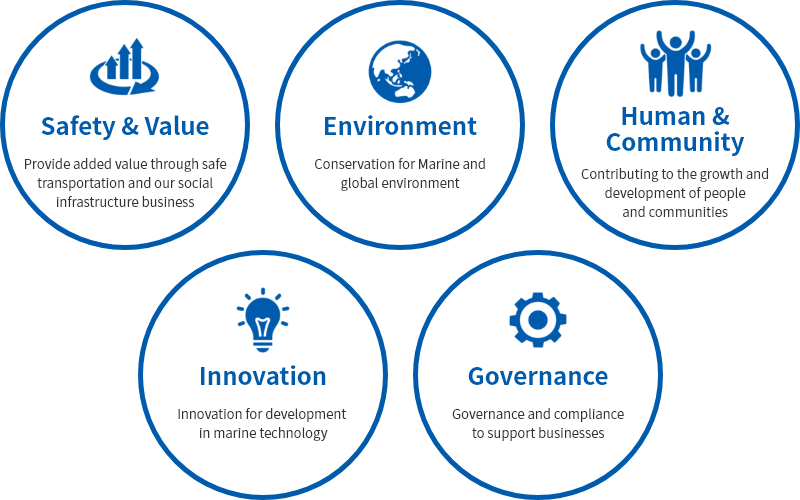
Identification and Review of Sustainability Issues
Identification process
In 2019, we formed the Sustainability Promotion Project Team to identify Sustainability Issues for the first time. This is an internal team with a cross-divisional membership that formulates our positions on social issues after studying both negative and positive social impacts of our business activities. Based on two axes of the importance to stakeholders and the importance to the MOL Group, we combine them under five topics.
When identifying Sustainability Issues (materiality), we are aware of two aspects (double materiality) of the impact of our group on the environment and society, as well as the impact of the environment and society on our group.
- STEP 1
- Review candidate Sustainability Issues
- STEP 2
- Examine risks (negative impact) and opportunities (positive impact) in value chains
- STEP 3
- Evaluate importance from two axes of stakeholders and the MOL Group
- STEP 4
- Identify Sustainability Issues
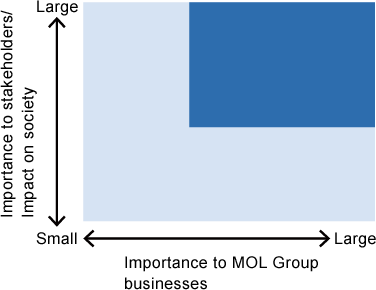
Review (FY2021)
Two years have passed since the first Sustainability Issues were identified, and in 2021 we reviewed them while referring to the opinion of external stakeholders (external experts, investors, NGOs, etc.), considering the changes in the business environment around the MOL Group, in addition to changes in the social environment, such as climate change, human rights issues.
This review was approved by the Board of Directors in September 2021.
- Before review
- Value-added transport services
- After review
-
 Safety & Value
Safety & ValueProvide added value through safe transportation and our social infrastructure business
- Specify attitude towards initiatives on "safety"
- Expand the scope to cover not only shipping, but also social infrastructure businesses such as offshore businesses.
- Before review
- Human resource cultivation and community development
- After review
-
 Human & Community
Human & CommunityContributing to the growth and development of people and communities
Change the intent to aim for success and co-existence not only among MOL Group executives and employees, but also among everyone involved in MOL Group businesses.
MOL Sustainability Plan
In order to accelerate its efforts to resolve Sustainability Issues, we have set goals, KPIs, and action plans for each of these issues, and formulated the MOL Sustainability Plan. This plan was approved by the Board of Directors in March 2022.
From FY2023, we reviewed the positioning of the "MOL Sustainability Plan" in the establishment of the "BLUE ACTION 2035" management plan and incorporated it as part of the "BLUE ACTION 2035" as an action plan to realize the Group Vision by resolving Sustainability Issues, thus further integrating the Sustainability Plan with the management plan. Accordingly, we made a partial revision of initiative focus, targets and KPIs, and changed the Action Plans to correspond with the content of Phase 1 (FY2023 to FY2025) in line with the management plan.
Through the steady implementation of MOL Sustainability Plan, we will strengthen our efforts to resolve Sustainability Issues, measure the effectiveness of our efforts, and implement appropriate improvement activities.
- Safety & Value (Provide added value through safe transportation and our social infrastructure business)
- Environment (Conservation for Marine and global environment)
- Human & Community (Contributing to the growth and development of people and communities)
- Innovation (Innovation for development in marine technology)
- Governance (Governance and compliance to support businesses)

Safety & Value Provide added value through safe transportation and our social infrastructure business
MOL aims to promote sustainability and prosperity in people's everyday lives and in industries around the world, by transporting energy, commodities, and finished products safely, reliably, and cost-effectively. The MOL Group continuously aims to expand its social infrastructure business, centered primarily on marine transport.






Our group's approach and strategy for safety : MOL Group Safety Vision
| Initiative Focus | Targets and KPIs *Figures in square brackets are target values. |
Fiscal 2024-2025 Action Plans |
|---|---|---|
| Value through Our Core Business | Provide sustainable value through marine transport and social infrastructure business |
|
| Transport volume (ton-mile) | ||
| Safety Levels | Ensure that the MOL Group can continue to protect precious people, property, and the environment and be trusted |
|
Group-wide KPIs for the MOL Group
|
||
Safe Operations
|
||
| Creation of New Added Value | Create services that meet social needs |
|
| Track record of new services that cater to society's sustainability-related needs | ||
| Number of projects commercialized through the MOL Incubation Bridge, system for employee-inspired proposals for new businesses |
- *1 Define and set for each business segment in the MOL Group.
- *2 Number of lost time injuries occurring in a workplace per 1 million hours worked (MOL uses "on board time" as denominator).
- *3 The amount of downtime due to mechanical malfunctions or incidents per vessel per year.
- *4 The number of mechanical malfunctions or incidents that result in downtime per vessel per year.
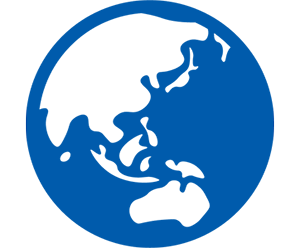
Environment Conservation for Marine and global environment
MOL aims to minimize the negative impacts of its business activities (marine environmental pollution, air pollution, reduction of biodiversity, climate change, etc.) and to ensure a sustainable world for everyone.





Our group's approach and strategy for environment : MOL Group Environmental Vision 2.2
| Initiative Focus | Targets and KPIs *Figures in square brackets are target values. |
Fiscal 2024-2025 Action Plans |
|---|---|---|
| Climate Change Countermeasures | Achieve net zero GHG emissions for the entire Group by 2050 |
|
| GHG emissions *1 [▲23% (FY2030, compared to that of 2019)] |
||
| GHG emission intensity *2 [▲1.4% per year (average through 2030, compared to that of 2019)] [▲45% (FY2035)] |
||
| Number of LNG/methanol-fueled ocean-going vessels [90 vessels (FY2030)] |
||
| Ratio of power from renewable energy
for Scope 2 [100% (FY2030)] |
||
| Fuel efficiency (Energy consumption per ton-mile) [▲5% (FY2025)] |
||
| Amount of removal type carbon credits used
(t-CO2) [2.2 million t-CO2 (FY2030, Cumulative)] |
||
| Environmental investment [6,500 billion yen (FY2021-23 in total)] |
||
| Preservation of Marine Environments Protection of Biodiversity | Reduce negative impact on the marine environment and biodiversity |
|
| *Planning to set KPIs based on international guidelines, etc. | ||
| Prevention of Air Pollution | Reduce air pollutants emitted from vessels | |
| SOx emissions | ||
| SOx emissions intensity [▲14% (FY2030, compared to that of 2020)] |
||
| NOx emissions | ||
| NOx emissions intensity |
- *1 Scope 1 and Scope 2 for the entire group (consolidated scope).
- *2 Scope 1 and part of Scope 3 for MOL Group-operated ocean-going vessels.

Human & Community Contributing to the growth and development of people and communities
MOL aims to achieve successful coexistence among everyone involved in the MOL Group businesses and the sustainable growth and development of communities through its activities as a corporate group that respects diverse personalities and that can maximize the capabilities of every employee.





Our group's approach and strategy for human capital : MOL Group Human Capital (HC) Vision
| Initiative Focus | Targets and KPIs *Figures in square brackets are target values. |
Fiscal 2024-2025 Action Plans |
|---|---|---|
| Diversity, Equity & Inclusion | Realize a work environment in which a diverse range of human capital can succeed |
|
| Percentage of managerial positions filled by women (Non-consolidated, office workers) [15% (FY2025)] |
||
Composition of people filling MOL Group Key Positions (MGKP) *1
|
||
| Mutually Empowered | Establish an environment for "Mutually Empowered" to maximize individual and group-wide organizational capabilities | |
| Communication implementation rate aimed at achieving and practicing the Group Corporate Mission, Vision, Values [100% (FY2025)] |
||
| Number of transfers due to the open recruitment
of positions Groupwide (cumulative figure over three years) [More than 50 cases (FY2025) *2] |
||
| Highly Engaged | Realize a group in which employees can feel the significance and peace of mind of working for the company on a daily basis | |
| Engagement Survey (ES) response rate [More than 90% (FY2025)] |
||
| Percentage of organizations where the KPI score for
"Engagement" improved in the ES [More than 70% (FY2025)] |
||
| Growing Together with Local Communities | Expand activities that contribute to the growth and development of people and communities involved in our business |
|
| Results of corporate citizenship activities | ||
| Progress of activities benefiting local communities in Mauritius |
- *1 General Managers in MOL head office(GMs), and positions in all the MOL GROUP companies, of which function and responsibility are designated to be equivalent to those of GM (irrespective of whether in Japan or overseas)
- *2 Cumulative total for 3 years
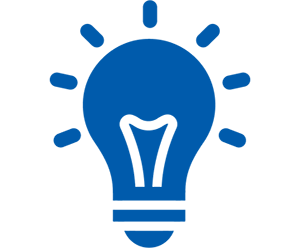
Innovation Innovation for development in marine technology
MOL aims to enhance its business through advanced technologies using clean energy and ICT, and to help address various social issues. This will also help the Group provide added value through safe transportation and our social infrastructure businesses and achieve its goal of conservation for marine and global environment.






Our group's approach and strategy for DX : MOL Group DX Vision
| Initiative Focus | Targets and KPIs *Figures in square brackets are target values. |
Fiscal 2024-2025 Action Plans |
|---|---|---|
| Groupwide Adoption of Clean Energy | Introduce and increase the use of clean alternative fuels for vessels |
|
| Number of net-zero GHG emission ocean-going vessels [Deploy commercial in the 2020s] [130 vessels (FY2035)] |
||
| Percentage of zero-emission fuels used [5% (FY2030)] |
||
| Develop technologies that contribute to the spread of clean energy in society |
|
|
| Progress in developing next-generation clean energy carriers/bunkering vessels | ||
| Increasing the Energy Efficiency of Vessels | Use natural energy and establish and promote energy-saving technologies that help improve propulsion performance |
|
| Number of vessels equipped with the Wind Challenger (hard sail wind propulsion system) [25 vessels (FY2030)] [80 vessels (FY2035)] |
||
| Number of vessels adopting other energy-saving technologies | ||
| ICT Utilization for Safe, Efficient Operation | Upgrade, expand, and establish platforms using vessel-related big data (the FOCUS Project etc.) |
|
| Progress of the FOCUS Project | ||
| Progress of the Fleet Guardian Project *4 | ||
| Establish technologies for autonomous vessel navigation |
|
|
| Progress in developing technologies for autonomous vessel navigation | ||
| DX | Digitalize to improve company productivity and optimize processes |
|
| Conversion rate to work for value creation (land-based work) *5 [15% (FY2025, cumulative)] [25% (FY2030, cumulative)] [30% (FY2035, cumulative)] |
||
| Conversion rate to work for safety (onboard duties) *6 [10% (FY2025, cumulative)] [20% (FY2030, cumulative)] [30% (FY2035, cumulative)] |
||
| Number of change leaders *7 |
- *1 Rotor Sail is an auxiliary device using wind power.
- *2 Propeller Boss Cap Fins. It improves propulsion efficiency by breaking up the hub vortex generated behind the rotating propeller of the vessel.
- *3 The optimum trim system quantitatively assesses MOL captains' extensive practical knowledge of vessel running attitudes through tank testing and tests aboard actual ships. This data is translated into graphs that make it easy for seafarers to use the system.
- *4 A predictive diagnostic system to prevent problems and breakdowns in the main engine, based on the information from various sensors monitoring the onboard main engine, etc.
- *5 Ratio of man-hours spent by employees on routine work to man-hours spent on new value creation through digital applications and optimization of operations and organization.
- *6 Ratio of man-hours spent by employees on routine work to man-hours spent on safety operations through digital applications and optimization of operations and organization.
- *7 Change leaders are defined as "A person promoting changes in business models, business processes, corporate culture, etc." and "A person who understands business and process issues, is able to envision the ideal state and lead the change". The number of employees receiving training to develop them as change leaders.
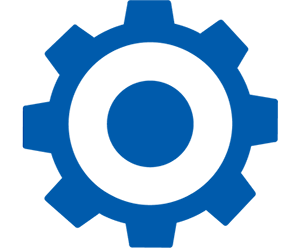
Governance Governance and compliance to support businesses
Through enhancement of corporate governance and thorough compliance, MOL aims to ensure transparency in Group wide management, build foundations for its initiatives on social issues through business activities, and establish sustainable value chains based on consideration for human rights, safety, and the environment.






Our group's approach for governance : MOL Group Three Basic Principles of Corporate Governance
| Initiative Focus | Targets and KPIs *Figures in square brackets are target values. |
Fiscal 2024-2025 Action Plans |
|---|---|---|
| Management Transparency |
|
|
| Results of effectiveness evaluations of the Board of Directors | ||
| Progress of deliberation of the Corporate Governance Council | ||
| Information Security | Zero serious ICT incidents |
|
| Number of serious ICT incidents *1 [0] | ||
| Responsible Procurement Respect for Human Rights | Identify and reduce risks related to the environment, safety, and human rights throughout value chains |
|
| Progress of value chain management | ||
| Track record on human rights training | ||
| Fair Trade Bribery Prevention | Zero compliance violations |
|
| Number of compliance violations *2 [0] | ||
| Number of consultations received by compliance advisory service desk | ||
| Track record on compliance training and e-learning |
- *1 Those that fall under Level 4 (most serious) of the four incident levels determined according to the scope of impact.
- *2 Serious violations related to fair trade and bribery.
